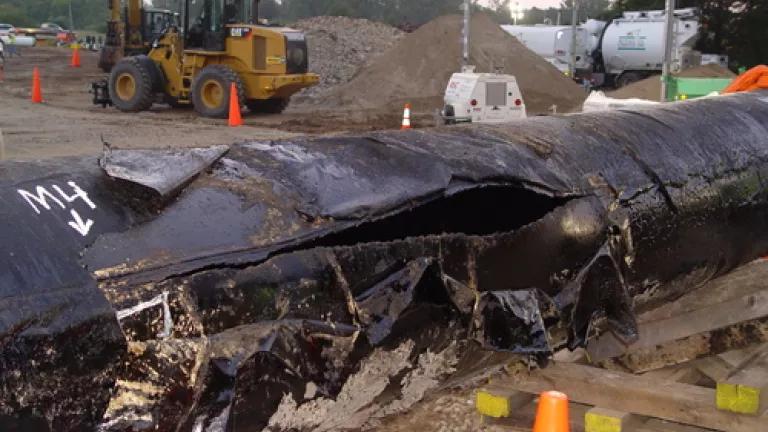
Proponents of the Keystone XL tar sands pipeline are using a disingenuous argument to avoid further scrutiny of TransCanada’s proposed pipeline. They argue that the concerns of landowners, farmers and first responders regarding the safety of Keystone XL are unreasonable because TransCanada has agreed to fifty-seven conditions suggested by pipeline safety regulators that will make it safer than other pipelines. There’s a serious flaw with this argument - most of the conditions TransCanada ‘voluntarily’ agreed to are also the minimum standards that all pipeline operators must follow. Recently, Secretary of State Hillary Clinton fell for this line, claiming that her Department had developed conditions that were “above and beyond what is required by law.” It is outrageous to see federal officials playing this shell game with the safety of the American public. These fifty-seven conditions are smoke and mirrors. The United States does not need this pipeline or the risks it poses to our communities and fresh water.
An analysis of the fifty-seven ‘special conditions’ which the Pipeline and Hazardous Safety Materials Administration (PHMSA) suggested reveals them for what they are – a public relations stunt taken at the public’s expense. It turns out that the majority of these conditions fall into three categories.
The first category includes twenty-eight conditions that repeat bare minimum safety standards that either PHMSA, the Federal Energy Regulatory Commission (FERC) or Canada already require TransCanada to comply with as a matter of law. This includes measures like meeting minimum strength requirements, putting down markers or inspecting the pipeline route at least twenty-six times a year.
The second category includes twelve conditions that TransCanada must take to ensure that Keystone XL isn’t actually operating below legal safety standards. For instance, testing to try to prevent problems with defective steel that were encountered with Keystone I. Or making sure that TransCanada isn’t using parts that aren’t rated for the pipeline’s operating pressure.
In the third category are the five conditions that require TransCanada to keep records and report to PHMSA its progress in complying with these voluntary ‘special conditions.’
That leaves a dozen conditions that actually differ in some way with minimum standards:
- Six of these include doing some early tests on the pipeline that are required of all pipelines in High Consequence Areas.
- TransCanada must provide PHMSA with its construction plans for Keystone XL… plans which are already publicly available here.
- There’s a boilerplate condition that Keystone XL be puncture resistant to 65 tons (all applications for special permits require this).
- TransCanada agrees to bury the pipeline six to twelve inches deeper than required by minimum safety standards. Of course, TransCanada already planned to do this before agreeing to these conditions.
- TransCanada must have a plan to validate the data provided by their leak detection system.
- TransCanada originally planned to have 104 shutdown valves – the company agreed to build two more.
- TransCanada agrees to keep the pipeline temperature under 150 degrees F without justification. Of course, this doesn’t actually change the high and potentially dangerous temperature at which Keystone XL operates – it only describes it.
- Finishing off the list are these minor changes: TransCanada agrees to copy PHMSA when it reports spills to the National Response Center, it’ll have cathodic protection in six months rather than a year, and it will run a pressure test for eight hours rather than four.
These conditions hardly justify the argument that due diligence for Keystone XL is unnecessary. They do, however, explain the abysmal record of past TransCanada pipelines which were approved with ‘special conditions.’ Two of these pipelines began operation last year with similar lists of conditions. One has since had a dozen leaks and the other exploded.
TransCanada agreed to fifty-one conditions for its high pressure Keystone I pipeline, describing the pipeline system as one that would “meet or exceed world-class safety and environmental standards.” After a year of operation, the pipeline has had a dozen leaks and is being investigated by federal pipeline safety regulators who found it to be an imminent threat to life, property and the environment.
TransCanada also touted the extra safety measures it was taking for its “state-of-the-art” Bison natural gas pipeline. In July, TransCanada’s six month old pipeline exploded, destroying a sixty foot section with a shock wave that could be heard thirty miles away. This is a surprisingly bad record for pipelines safer than the law requires.
To make matters worse, TransCanada appears ready to use these conditions “to request a special permit in the future.” With a special permit - formerly called a safety waiver - TransCanada could operate the Keystone XL tar sands pipeline at higher pressure than minimum standards allow.
One reason to question the effectiveness of Keystone XL’s special conditions is that pipeline safety regulators admit they don’t understand the risks presented by the pipeline. In a Congressional hearing in June, top pipeline safety regulator Cynthia Quarterman admitted that her agency had not studied the risks posed by tar sand pipelines and was not able to comment on them. Even when acting in good faith, it is difficult for an agency to effectively manage risks it hasn’t investigated and doesn’t understand
Of course, unless PHMSA doesn’t know its own regulations, it is difficult to imagine that this list of fifty-seven special conditions was written in good faith. It is being packaged as a list of conditions that manage the higher risks presented by Keystone XL. In truth, they are a hodgepodge of current regulations – some conditions actually repeat regulations word for word – and red herrings. Dressing these as answers to legitimate safety concern is both a disgrace and an insult to the American people.
It’s time for the State Department and PHMSA to stop shirking their responsibilities and do due diligence.
Photo courtesy NTSB

